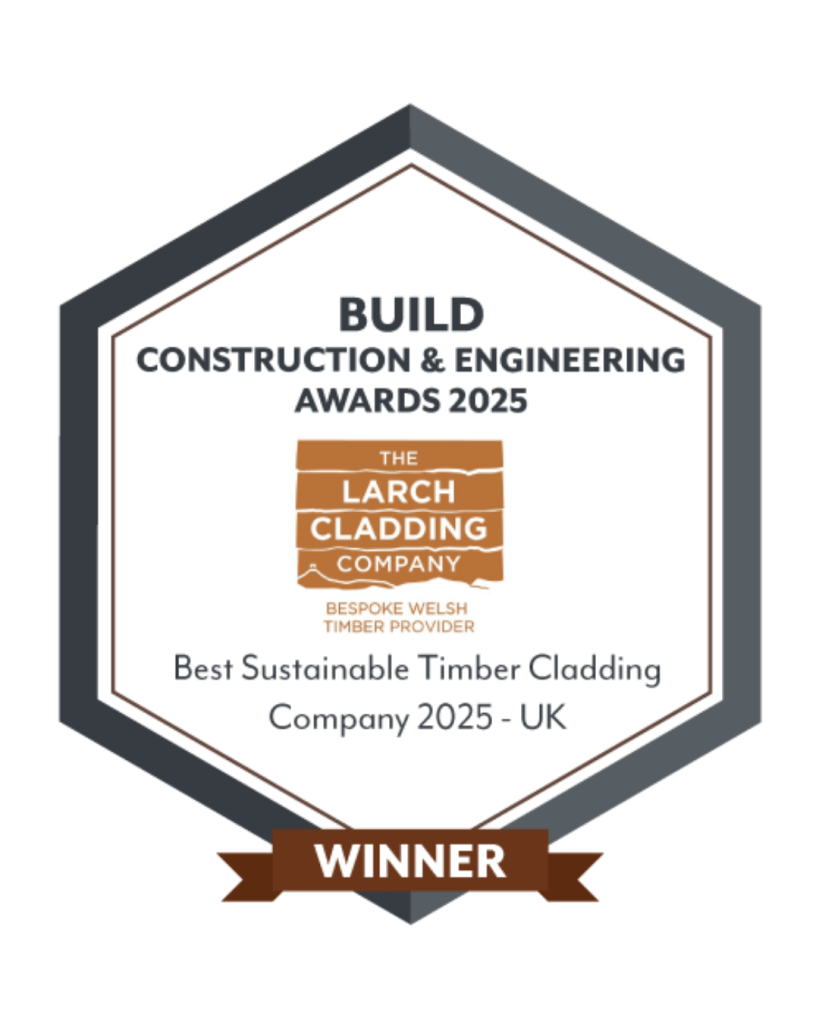Charred Timber Cladding




Charred Timber Cladding Sourced in Wales
Charred Timber Cladding, also known as Burnt Timber Cladding, is a dramatic and durable choice for exterior cladding. Created using the traditional Japanese method of Shou Sugi Ban, the surface of the timber is carefully charred to enhance its resistance to moisture, pests, and weathering. This ancient technique not only increases the lifespan of the timber but also results in a deep, rich finish that adds striking character to any structure. Our Charred Larch Cladding is a particularly popular choice, offering a bold blackened appearance with the natural grain of the wood still visible beneath the charred surface, perfect for projects that blend modern architectural lines with natural textures.
At The Larch Cladding Company, we specialise in premium-quality charred timber cladding products, crafted from sustainably sourced timber grown in managed UK forests. Our burnt cladding combines high-performance durability with low-maintenance design, making it an excellent choice for contemporary homes, commercial buildings, garden rooms, and rural properties. Thanks to its improved protective qualities, it performs well in the UK climate and maintains its stunning appearance for years to come without the need for chemical treatments.
The rich, black aesthetic of our black timber cladding offers a unique alternative to painted finishes. It provides a naturally fire-resistant, insect-repelling, and rot-resistant surface, without compromising on beauty. Ideal for use in both modern and rustic settings, charred cladding has become especially popular for agricultural-style conversions and new-builds seeking a bold exterior finish. Our black barn cladding, particularly when specified in black barn feather edge cladding, delivers a timeless and textural look that is both understated and dramatic.
We offer a variety of profiles to suit your design vision, including traditional feather edge, square edge, shiplap, and shadow gap, each available in a beautifully charred finish. Black barn feather edge cladding, in particular, is a favourite among clients looking to preserve the agricultural roots of a property while introducing a contemporary edge.
Whether you are cladding an entire home, creating a feature wall, or revitalising a barn conversion, our charred timber cladding products deliver exceptional performance and eye-catching results.
By choosing charred cladding from The Larch Cladding Company, you’re investing in a natural, sustainable, and visually stunning material that will enhance your building for years to come. We provide expert advice, cutting services, and nationwide delivery, making it easy to specify burnt timber cladding with confidence for your next project.
Contact us today to request a quote, order samples, or learn more about our range of charred timber cladding and charred profiles for modern and traditional builds alike.
– British larch sourced in Wales
– From FSC managed forests
– Overall finished widths 70mm / 95mm / 145mm
– Supplied uncoated
We offer a range of timer cladding profiles that can be viewed on our timber cladding profile page.
Installing charred timber cladding, also known as Shou Sugi Ban, involves several careful steps to ensure both durability and an aesthetically pleasing finish. Charred timber cladding offers a unique, striking appearance and enhanced durability due to the charring process. Here’s a short guide on how to install charred timber cladding:
Tools and Materials Needed
- Charred timber cladding boards
- Stainless steel nails or screws
- Hammer or screwdriver (depending on your choice of fasteners)
- Saw
- Spirit level
- Breathable waterproof membrane (if required by your application)
- Battens (for creating an air gap behind the cladding)
Preparation
- Measure the area to be clad to determine the amount of charred timber cladding needed.
- Select the grade and profile of charred timber cladding according to the desired appearance and functionality.
- Prepare the wall surface, ensuring it is clean, dry, and flat. If you’re applying cladding over insulation or to an uneven surface, you might need to install a frame of horizontal battens fixed to the wall.
Installation Process
Install a breathable waterproof membrane: If necessary, start from the bottom and overlap sheets by at least 150mm as you move up.
Fix horizontal battens: Attach these to the wall if required, spaced to match the cladding profile. Ensure they are level and allow for ventilation at the top and bottom.
Start cladding installation: Begin from the bottom corner of the wall. Use a spirit level to ensure the first board is perfectly horizontal.
Attach the cladding boards: Fix the charred timber cladding boards to the battens using stainless steel nails or screws. Leave a small gap (typically 2mm) between boards to allow for expansion.
Overlap or join the cladding boards: Follow the chosen style (e.g., ship-lap, tongue and groove). Ensure any joints between boards are staggered across the wall to enhance strength and appearance.
Work upwards: Continue to work your way up the wall, ensuring each board is level before fixing it in place. Trim any boards to fit around windows, doors, or corners.
Finishing: Charred timber cladding typically does not require additional treatments due to the protective properties conferred by the charring process. However, you can apply a suitable exterior-grade oil or sealant if desired to enhance the color and longevity.
We’re proud to supply premium-quality trade timber to professionals throughout the UK’s construction and design industries. Whether you’re an architect, contractor, engineer, estimator, or quantity surveyor, our sustainably sourced, precision-cut timber is crafted to meet the demands of today’s building and joinery projects.
Benefits of Charred Larch Cladding

Increased Resistance to Rot

Absence of Pests and Other Insects

Long Life and Minimal Maintenance
Charred Timber Finishes Explained
Charred Timber Cladding can be customised to achieve different levels of charring, often referred to as rare, medium, and well-done finishes. Each level offers a unique aesthetic and degree of protection for the wood.
Light

Appearance: A rare burn provides a light charring that retains much of the wood’s natural grain and texture. The finish is subtle, with a slightly darkened surface that highlights the wood’s inherent beauty.
Benefits: This level of charring offers moderate protection against weathering and insects while maintaining a more natural look. It is ideal for those who want a touch of the charred effect without completely altering the wood’s original appearance.
Medium

Appearance: A medium burn results in a more pronounced blackened finish while still allowing some of the wood’s grain to show through. The surface is darker and more uniform compared to a rare burn.
Benefits: Medium charring enhances the wood’s resistance to rot, pests, and weathering more effectively than a rare burn. It provides a balanced combination of aesthetic appeal and durability, making it suitable for a wide range of architectural styles.
Deep

Appearance: A well-done burn creates a deep, blackened surface with a strong, textured finish. The wood’s grain is heavily charred, resulting in a dramatic and bold look.
Benefits: This level of charring offers the highest degree of protection against environmental factors, including moisture, UV radiation, and pests. The robust finish ensures long-lasting durability and minimal maintenance, perfect for those seeking a striking and resilient cladding option.
Charred Timber Cladding FAQ
Yes, Charred Timber Cladding is highly durable. The charring process increases the wood’s resistance to weathering, rot, and insects, ensuring a long-lasting and low-maintenance exterior for your building.
Charred Timber Cladding requires minimal maintenance. Its natural resistance to decay and pests means that it does not need frequent treatments or upkeep. Occasional cleaning with a soft brush or water can help maintain its appearance.





